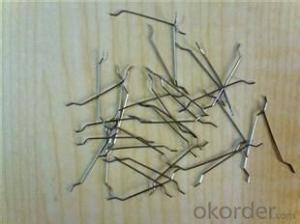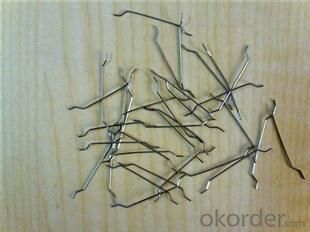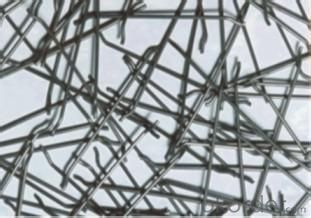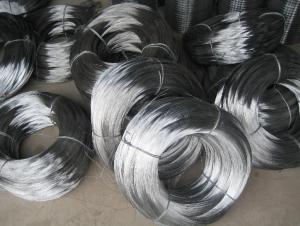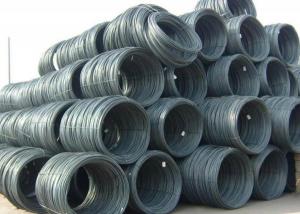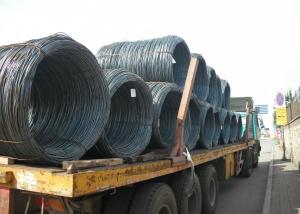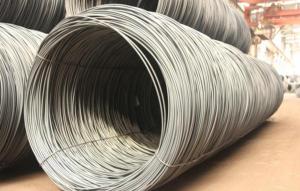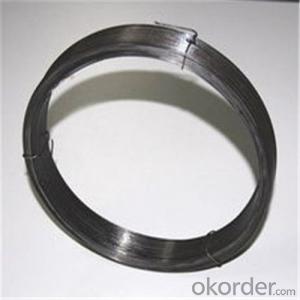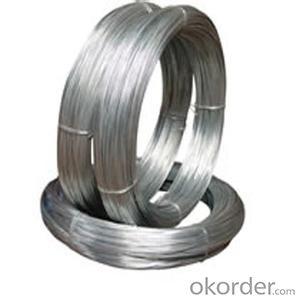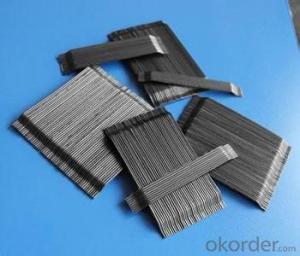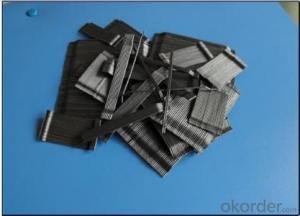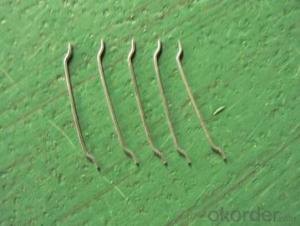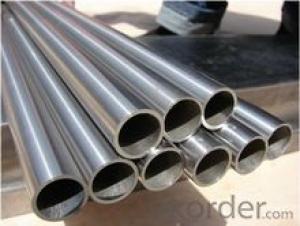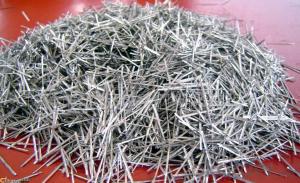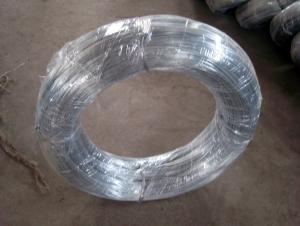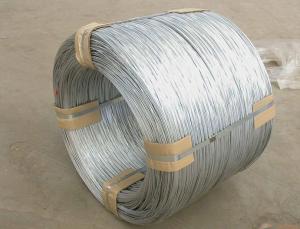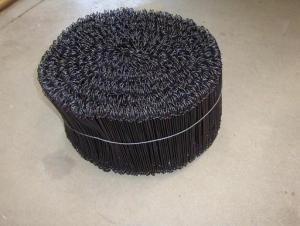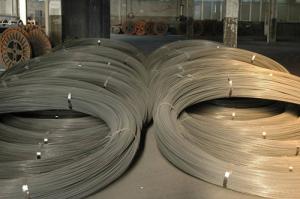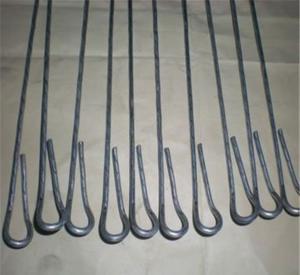Iron steel constructions steel fiber from CNBM
- Loading Port:
- Tianjin
- Payment Terms:
- TT OR LC
- Min Order Qty:
- 1 m.t.
- Supply Capability:
- 10000 m.t./month
OKorder Service Pledge
Quality Product, Order Online Tracking, Timely Delivery
OKorder Financial Service
Credit Rating, Credit Services, Credit Purchasing
You Might Also Like
Quick Details
Place of Origin: Tianjin, China (Mainland)
- Model Number: 0.55
Material: Steel
Production Process: Cold drawn
Fiber Lengh: 35
Type: 1
Compressive Strength: >1200MPa
Aspect ratio: 63
Standard: ASTM A820M-11
Section Shape: Circular
Application: Concrete Reinforcement
- Product Application: Industrial Floor
Packaging & Delivery
| Packaging Details: | 20 kg/Bag,50 bags/Pallet or 1,000kg/ Bulk Bag |
|---|---|
| Delivery Detail: | 1 Month |
Specifications
1.Deformed cold-drawn wire,Hooked-end
2.Aspect ratio:60-80
3.Tensile:1200Mpa
4.Diameter:0.5-0.9mm
5.Length:30-60mm
Product Description
| Diameter | 0.55 mm (0.217 in) | ||
| Length | 35 mm (13.780 in) | ||
| Aspect Ratio | 63 | ||
| Tensile strength | 1200 MPa | ||
| Type | Cold drawn Steel Fiber | ||
| End | Hooked-end Steel Fiber | ||
| Glued/Loose | Glued Steel Fiber | ||
| Bending Angle | 45°(min.30°) | ||
| Usage & Performance | Floor:Trafficked areas and Industrial floors | ||
| Shotcrete :Slope stabilization and Final lining | |||
| Precast concrete:Pipe and Railway sleepers | |||
| Packing | Standard Export Pallet Packing | Bag Packing | 20 kg/Bag,50 bags/Pallet |
| Bulk Packing | 1,000kg/ Bulk Bag | ||
| Loading Quantity | 20’GP | 20-25 Tonne/Tonnes | |
| 40’GP | 25-27 Tonne/Tonnes | ||
| 40’HQ | 25-27 Tonne/Tonnes | ||
| MOQ | 1 kg for trial order | ||
| Supply Ability | 10,000 Tonne/Tonnes per Year | ||
| Payment Terms | T/T or L/C at sight | ||
| Delivery Time | Within 15 days after receiving deposit or original L/C at sight | ||
| Certification | ISO9001:2000, CE, | ||
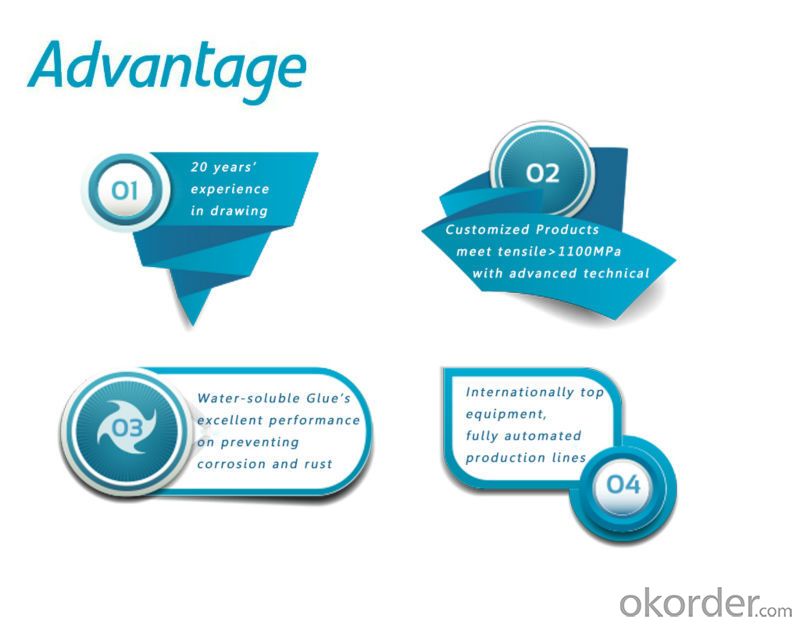
| Product | Diameter | Length mm/in | Aspect Ratio | Type | Packing |
| G-6030 | 0.5 mm (0.197 in) | 30 mm (11.811 in) | 60 | Glued | 20 kg/Bag, or 1,000kg/ Bulk Bag |
| G-6535 | 0.55 mm (0.217 in) | 35 mm (13.780 in) | 65 | Glued | 20 kg/Bag, or 1,000kg/ Bulk Bag |
| G-6035 | 0.6 mm (0.236 in) | 35 mm (13.780 in) | 60 | Glued | 20 kg/Bag, or 1,000kg/ Bulk Bag |
| G-8060 | 0.75 mm (0.295 in) | 60 mm (23.622 in) | 80 | Glued | 20 kg/Bag, 50 bags/Pallet |
| G-6060 | 0.9 mm (0.354 in) | 60 mm (23.622 in) | 60 | Glued | 20 kg/Bag, 50 bags/Pallet |
| G-6030 | 0.5 mm (0.197 in) | 30 mm (11.811 in) | 60 | Loose | 20 kg/Bag, or 1,000kg/ Bulk Bag |
| G-6535 | 0.55 mm (0.217 in) | 35 mm (13.780 in) | 65 | Loose | 20 kg/Bag, or 1,000kg/ Bulk Bag |
| G-6035 | 0.6 mm (0.236 in) | 35 mm (13.780 in) | 60 | Loose | 20 kg/Bag, or 1,000kg/ Bulk Bag |
| G-8060 | 0.75 mm (0.295 in) | 60 mm (23.622 in) | 80 | Loose | 20 kg/Bag, 50 bags/Pallet |
| G-6060 | 0.9 mm (0.354 in) | 60 mm (23.622 in) | 60 | Loose | 20 kg/Bag, 50 bags/Pallet |
- Q: So I customized my guitar, and now I need to wire it. i have a pre-wired pickguard but I don't know how to actually hook it up. There's 3 wires. I have 2 humbuckers, 1 singlecoil, 1 tone, and 1 volume. All I know is that one wire gets soldered to the back where the springs are and another wire goes to the input jack. But there's a 3rd wire and I don't know where it goes. I don't even know which wire goes to what. Please don't post a diagram because it doesn't help. I think the wire colors are white, blue, and yellow. Please help!
- OK...I okorder /... That should hook you up.
- Q: I have a 1996 Cadillac Deville Sedan, and I bought a female wiring harness for it off of the internet. The Factory Wires doesn't include pink, but yet all the wiring codes say pink...the adapter I bought matches up to the Head Unit I want to replace the factory with, but when i put the battery back on and everything it doesn't turn on, I need to know how to wire this thing correctly, and if I bought the wrong adapter or not...Thank You.
- do not take heed to the fairway police out the following. relying on what issues your questioning about, eliminating it ought to or may no longer reason issues. in case your anxious about your automobile magically blowing up, it WONT! you'll unlock a touch of airflow contained in the exhaust and also you'll have more advantageous skill. the automobile will also sound only a touch louder. in case you've already got loud mufflers like glasspacks it will be too loud on your style. Your verify engine gentle will sometimes turn on and rancid purely because your pc realizes that somethings lacking from the O2 sensor readings. As for gas economic gadget, anticipate little or no change. possibly a moderate progression because the exhaust flows more advantageous ideal without the reduce. Thats it! A cat isn't an mandatory gadget to the operation of your automobile. Its a downside to it. in case your anxious about the legality of it, its unlawful. yet purely how may you get stuck? possibly if its obnoxiously loud, you will get pulled over. in case you stay in a community that does emissions finding out and/or seen inspection to get your tags, your going to might want to positioned it again on once you pick to get those checks carried out. To the different answerers, if the asker became worried about environmentally conciousness they does no longer have requested this contained in the first position. thanks. I have a Mustang GT i have been using without cats for over a year. a lot more advantageous skill, sounds good, and totally reversible even as i pick to resume my tags.
- Q: i want technical names of the electrical equipments rheostat,wire wound
- 1.Rheostat is Rheostat. But if you are asking technical name , I would like to state : A potentiometer is a three-terminal resistor with a sliding contact that forms an adjustable voltage divider. If only two terminals are used (one side and the wiper), it acts as a variable resistor or Rheostat. 2.Wire:Cable. A wire is a single, usually cylindrical, elongated string of drawn metal. Wires are used to bear mechanical loads and to carry electricity and telecommunications signals. Standard sizes are determined by various wire gauges. The term wire is also used more loosely to refer to a bundle of such strands, as in 'multistranded wire', which is more correctly termed a wire rope in mechanics, or a cable in electricity. 3.Wound : Do you mean winding?
- Q: Am I able to do this? The wire burn the clay?
- if you're using a clay like the 3 main Sculpeys (original Sculpey, SuperSculpey, and Sculpey III), you will especially want to use wire inside them (or use other kinds of armatures) in any thin or projecting areas since those lines of polymer clay are brittle after curing in those kinds of areas
- Q: Consider a copper wire 1 mm in diameter providing the power needed to run an appliance drawing a 4.8 kW at 12 V. Assuming that no heat is radiated away from the wire while the current flows:A. What will the temperature of the wire be after the current has run for 1 second through the wire?B. What will the physical condition of the wire be at that time?(The wire was initially at 20 degrees C)
- Battery's have their very own resistance (noted as their 'inner resistance'). the cost of the indoors resistance relies upon on the form of battery and its age. the full resistance of your circuit hence would be plenty greater effective than 0.064 ohm, so the present would be decrease than ninety 3.75A.. you will no longer get a electric marvel from 6V (although your tongue can detect it - no longer recommneded!). approximately 30mA around the guts can quit it. yet you may choose a plenty bigger voltage than 6V by way of resistance of the physique. in spite of the shown fact that there is achieveable of overheating the battery and/or the twine, which includes achieveable of hearth in some circumstances. Please do no longer attempt this with AC mains. There are severe detrimental aspects of deadly electric marvel and beginning a hearth. The kin risk-free practices equipment (fuse/circuit breaker/RCD) are meant to shrink the skill if the present is basically too severe or if there is an earth-leak - yet you are able to no longer possibility the risk-free practices of your self and others in this kind.
- Q: does anyone know what wires go on which post on a 1995 chevy lumina 3.1 starter? it was off when i bought the car and im lost. i cant find a straight answer anywhere. a picture of the wiring in question is an instant best answer lol
- it only has on wire and its not a very big wire shouldn't be that hard to find follow the wire off the battery to the solenoid then its one of the wires off of that
- Q: I am building an ice chest boombox and want to wire a toggle (on/off) switch to turn the amp on and off....the amp is wired directly to the battery....my question is that I am using 6 gauge wire....but can't find any female spade connectors that are 6 or even 4 gauge to hook to the terminals on the switch.....what is a simple way to do this....am I going to have to solder the wire straight to the terminals?
- Why not wire the toggle switch into the remote + wire? The one that turns the amp on and off with the head unit. 7/5/2013**** Leave the power supply wire alone. The thick 4 gauge wire that runs from the battery directly to the amp, leave it alone, don't put a toggle switch inline on that wire. Instead there's a wire from your head unit (or ignition) that runs to your amp, it turns on the amp when the head unit turns on or your ignition key is in the on position. It's usually 16 or 14 gauge. That's the wire where the toggle switch belongs. Look at your amp, this wire I am speaking of is probably labeled remote+ or ign or something like that and it's usually located next to your power and ground connections on the amp.
- Q: remote 2 wires for power black - white also 3 wires to goto fan/light ? white - black - red
- wire it black to black white to white. original wiring could be wrong. please better description. for light kit red or blue should connect to that. dont forget grounding wire even though white wire polarizes
- Q: i have a 92 saturn and bought the wire harness, i put all the wires together and all that turned on was the theft light that comes on when you take off the face after that i tried putting the red and yellow wires together and it worked, just without the key having to be in the ignition and i think that is why the stereo gets so hot so can youall tell me how to wire it correctly?
- The red is the main power or acc power that comes on when car key is turned. The yeallow is for the memory for radio. Another word when u store a preset radio station that yellow wire supplies continues power to store mem for ever or untill u have to change batt. The reason y it worked when u hooked yellow and red to gether is they where both getting power. If one dosent get power it will no work. Check radio fuses for the yellow wire to see if it out. If u have manuel to car that would help. I had a mustang that with the yellow wire was dead i traced the wire tried to find the prob but could not. I ran a wire from batt to radio where the yellow wire hooked up. That is the same thing just try to keep the wire away from hot areas and door jams try to runn it through the firewall of the car.
- Q: Hello my question are:Examples given for wired and wireless communications systems?Compare and contrasted how wired and wireless communications systems function? Assessed the risks associated with wired and wireless communcations systems?(if you can put in simple details that would be helpful, because I understand parts of it but not all)Thank you
- I additionally want under pressure out. i began out with instantaneous, however the mouse only went by hundreds of batteries, and can crap out on me while i replace into authentic interior the midst of something. Now i take advantage of a under pressure out mouse. My keyboard continues to be instantaneous nonetheless.
Send your message to us
Iron steel constructions steel fiber from CNBM
- Loading Port:
- Tianjin
- Payment Terms:
- TT OR LC
- Min Order Qty:
- 1 m.t.
- Supply Capability:
- 10000 m.t./month
OKorder Service Pledge
Quality Product, Order Online Tracking, Timely Delivery
OKorder Financial Service
Credit Rating, Credit Services, Credit Purchasing
Similar products
Hot products
Hot Searches
